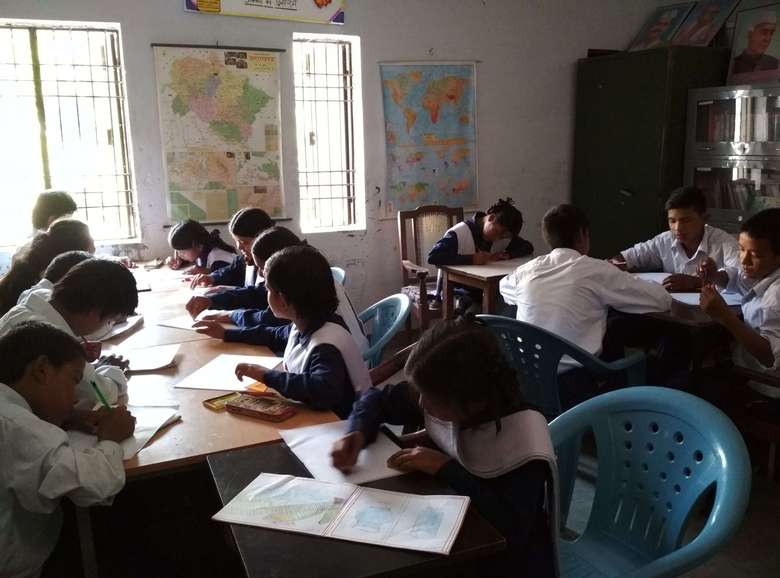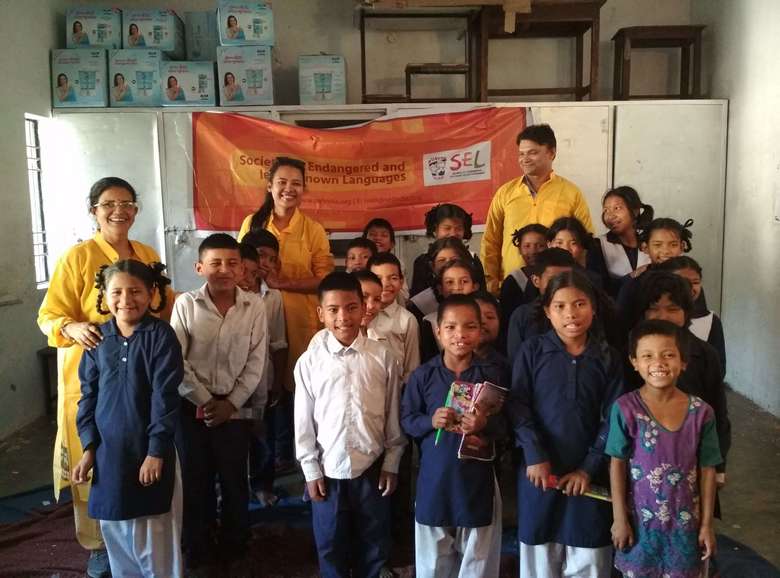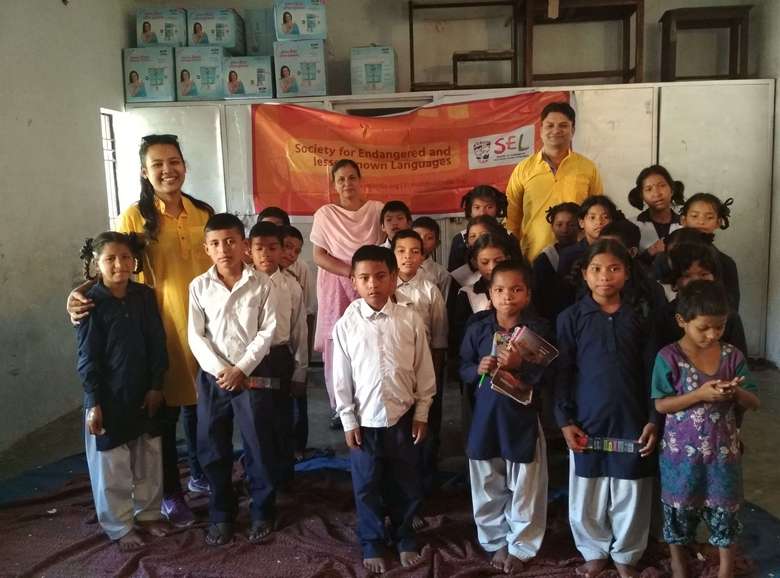


On 11th October 2017, a three-member team of linguists set forth to Kathgodam, Uttarakhand, on their way to Jauljivi, to evaluate a language revitalisation bid undertaken by Dr. Kavita Rastogi 8 years ago. The team arrived at Kathgodam at 12 30 PM and began their journey forth in a taxi. They travelled for about 9 hours on roads that were winding and swirling, causing one of the team members to take sick. A quick stop and some refreshment assured that everything was well by the time Pithoragarh arrived. After Pithoragarh, the team had to brave roads that were screaming for repair and any attempt to sleep or even rest the heads were proving futile. After three and a half hours on the road post-Pithoragarh, the team arrived at our Jauljivi rest stop, Joshi ji’s river-facing guest house. It was a total of 9 hours by train to Kathgodam, 6 hours by car till Pithoragarh and 3.5 hours by car till Jauljivi, a journey undertaken without a break of more than half an hour. We had a wonderful home-cooked dinner at Joshi ji’s and went for a much need sleep.
The next morning, the team went to the Rajakiya Ashram Paddhati Uchchatar Madhyamik Vidyalaya, Baluwakot, Pithoragarh. The school is residential, providing food, lodge and education to the ‘janajatiya’ children of the area. Since we were interested in the Raji children, the team collected the data about this community only. However, if anyone wants to collect data on other communities, that too is available. The principal of the school informed us that 63 Raji children were residents of the school currently, including 18 of the 25 students who were previously studying in the Raji Avasiya Vidyalaya that unfortunately shut down around two months ago. He also informed us that attempts to reach the other seven students were on and he is hopeful of admitting them to the school as well. The Raji students were between 5 to 15 years of age.
Our team gathered information on the general attitude of the Raji children towards education, community living, following instructions, teamwork, caring for others, hygiene, etc. from the teachers and caretakers working in the institution. We had a short interactive session with the students wherein we tried to make ourselves familiar to them as we knew, the children won’t respond to strangers, at least not the way we wanted them to. We left on Day 1 with data on the children’s age, general IQ and attitude towards education, team playing and residential living. On our way back to Jauljivi, we stopped at the Jauljivi Inter College that had a few Raji students and the old, now abandoned Raji Avasiya Vidyalaya to take a few pictures of how it stands now.
On Day 2, the team had to begin working with the students at one o clock. We had our morning free. So, we headed to the market in search of Raji speakers who would talk to us. At Harish ji’s shop, we met Bhagirathi ji, who was a Raji speaker. Dr. Rastogi and I had a long conversation with her wherein we found several words for certain diseases, medicinal plants, etc. In the same shop, we spoke to several other women who were either on their way to cut grass or meet their children studying at the Baluwakot school. The women, accompanied by a man were reluctant to speak at first, not making eye contact or simply shaking their heads when we asked a question. However, as soon as the man left, they opened up. The Raji Varnmala previously created by Dr. Rastogi embellished with the picture of a local Raji woman they all knew was a big help as an icebreaker. Everyone began talking, and we could gather a lot of new information. With a promise to meet again, we left for the school now as it was time to interact with the children.
We created activities to gauge the linguistic attitude of the children, measure their Raji vocabulary and find out the extent of linguistic transference if any. Of course, it was a difficult task—the children were extremely energetic, loud and desperate to get our attention. But we managed to channel their energy towards the activities by hiding some of our questions and queries in stories, songs and examples. The children participated in the activities we designed for 3 hours. We recorded their answers, and in the end, gifted them with pencils, sharpeners, erasers and colouring boxes. We also presented the Principal of the school and two of the teachers involved with us with certificates of appreciation.
Day 3 began with two of the team members leaving Jauljivi for a hamlet up in the hills called Jamtari. Jamtari houses around 45 Raji families and is located about 2000 feet above sea level. It was no minor feat for Vishnu ji and me to have done that climb in 2.5 hours. On our way, we clicked pictures of local flora, so that we could ask Raji speakers to name them and state their benefits if any. We were helped by Subedar Himmat Singh Samant, who was not a Raji speaker, but having lived in the area knew certain words. We obviously later, cross-checked with an actual Raji speaker and recorded their data as well. In the hills, we lost our way and overshot the Raji village by at least half an hour’s travel time. On our way back, we stopped at the Rajakiya Uchchatar Madhyamik Vidyalaya, Jamtari and were warmly welcomed by their Principal. He asked us the purpose of our research and assigned two Raji boys and two Kumaoni boys to show us around. We grabbed the opportunity and gathered the data from this group. The presence of the Kumaoni boys was better as it gave us a visible example of linguistic transference. The boys took us to their village where we met a very old Raji woman. Now, Raji average life expectancy is 60-65, with the upper limit being very rare. This grandmother, however, did not know her age but looked much older. We collected some very valuable data from her about solar and lunar eclipses, rainbows and the art of making a jhaadu or babyo. We returned to Jauljivi tired, but extremely satisfied with our data.
On day 4, Vishnu ji and I set out for Kimkhola, another hamlet again much higher in the hills with a steeper climb than Jamtari. Braving the same, we climbed up and were met with by Saraswati, a very valuable informer. With some coaxing, Saraswati informed us with the names of flora we wanted to collect and traditional rituals during festivals. She also gave us something previously not heard of, namely, a Raji song. Saraswati told us the significance of the song and when it is sung. Although we are yet to crosscheck this data, this is extremely encouraging for a young researcher like me who had read previous reports stating that the community does not have music and dance. Moving on, we spoke to a few children on the way as well, while Dr. Rastogi, back on land, talked to several women of the community who told her about traditional jewellery and their making process. We returned to Jauljivi by 11 o clock, having left at around 7, and set forth to Askot, where a group of Adivasi women were meeting on the occasion of Mahila Kisan Divas, organized by local, very active NGO named Arpan. We expected to speak to a few Raji women there, however, due to their involvement in the event, we didn’t get the opportunity.
We returned to Pithoragarh, halted for the night and boarded our train to Lucknow the next day from Kathgodam.





